
Understanding consumer shopping trends is crucial for businesses to effectively target their marketing efforts. Generational cohorts exhibit distinct purchasing behaviors, values, and preferences that significantly impact their consumption patterns.
Marketers have been focusing heavily in recent years on marketing to millennials as they establish households and come into more spending power.
For some time, marketers have been adjusting their marketing tactics to appeal to this age group, those consumers who are approximately between 27-41 years old. And for good reason, in 2024, millennials had a global spending power of $2.5 trillion (Visual Capitalist).
Gen Z has emerged as a powerful consumer force, wielding significant spending power. This digitally native generation possesses a unique set of purchasing behaviors and values. With a projected global spending power exceeding $450 billion (Statista), Gen Z is a highly influential market segment.
Every generation brings its own unique perspective to the marketplace. A well-rounded marketing campaign explores the habits of each unique group, from their preferred shopping channels and product choices to their values and priorities when making purchasing decisions.
Generational Consumer Shopping Trends
Over the years, brands have developed diverse marketing techniques to effectively appeal to each. These strategies recognize the unique values, preferences, and communication styles of each age group.
Let’s break down the generations, what makes them unique, and their different spending habits.
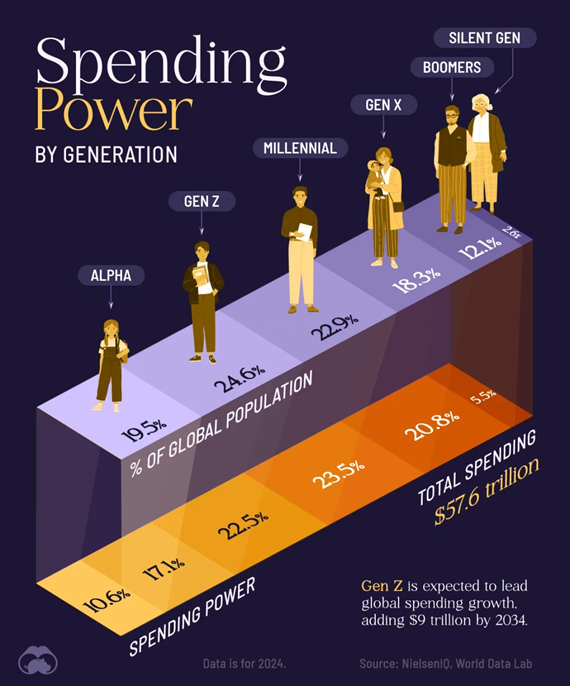
(Source: World Data Lab)
- Baby Boomers (ages 61-79) have an estimated spend of $5 – $6 trillion annually.
- Gen X (ages 45-60) follow Boomers with an estimated $4 – $5 billion annual spend.
- Millennials (ages 29-44) have an estimated $3 – $4 trillion annual spend.
- Gen Z (ages 13-28) have a $1.5 – $2 trillion annual spend,
Baby Boomers
Born between 1946 and 1964, this group remains a significant economic force.
Their substantial spending power is driven by factors such as increased longevity, retirement savings, and a desire to enjoy life.
Baby Boomers’ spending habits often prioritize travel, healthcare, luxury goods, and experiences such as dining and entertainment.
- Boomers make up 20.8% of the global spending power.
- 62% of Baby Boomers use social media: (Pew Research Center)
- 69% of baby boomers prefer brands to contact them via email. (Business Dasher)
- According to GWI 90% of Baby Boomers don’t feel represented in the advertising they see.
Here are the areas they are most likely to treat themselves:
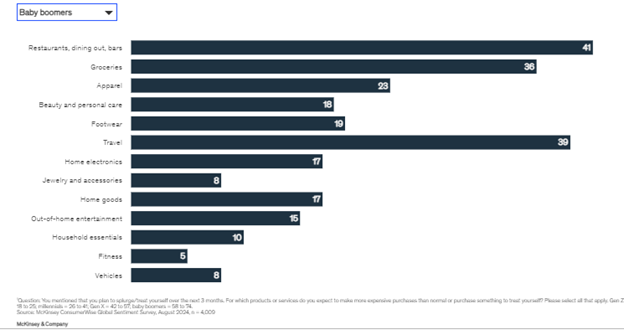
Gen Xers
Born between 1965 and 1980, they contributed an estimated $7 trillion to global consumer spending. (Bank of America Institute)
Email marketing is the preferred channel by about 80% of Gen Xers. Busy with careers and families, they don’t always have time to read long copy so keep it short with a clear call-to-action.
This generation also tends to be more loyal than other generations. They love freebies and coupons so show them some love and they will return the favor with long-term loyalty to your brand.
Facebook is their favorite social platform so reach out with engaging posts and entertaining content.
- Many consumers in this age group have significant financial responsibilities, often supporting both their children and aging parents. (World Economic Forum)
- Over 70% of Gen Xers prioritize experiences over material possessions. (Deloitte)
- Healthcare spending was a major category for Gen Xers, with a focus on preventative care and wellness. (Statista)
- Gen Xers were more likely to prioritize brand loyalty and customer service. (Gartner)
Here are the areas they are most likely to treat themselves:
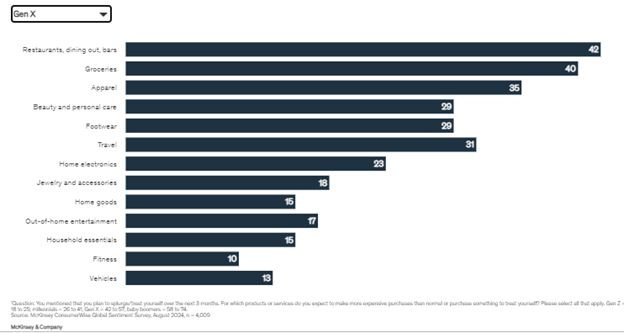
Millennials
Born between 1981 and 1996, they are the current focus group of most marketing efforts.
In 2024, this generation boasted a substantial global annual spending power. They’re known for their tech-savviness and focus on experiences, Millennials prioritize dining out, travel, and entertainment in their spending habits.
hey are also a significant force in the e-commerce market, driving online shopping trends and embracing subscription services.
- Approximately 60% of Millennials shop online at least once a week. (eMarketer)
- Millennials are more likely to use Buy Now, Pay Later (BNPL) services. (Statista)
- Millennials spend approximately 30% of their income on dining out. (Statista)
- Millennials are more likely to support brands that align with their values (e.g., sustainability, social responsibility).
Here are the areas they are most likely to treat themselves:
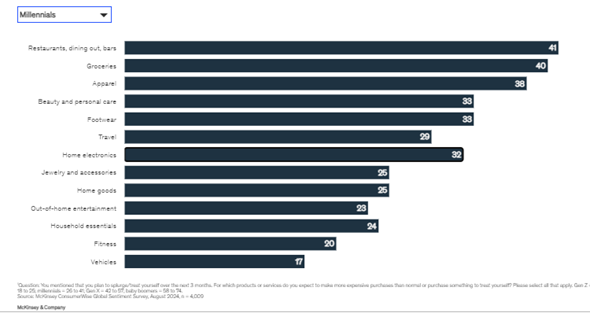
Gen Z
Born between 1997 and 2012, they represents a significant consumer force with an estimated global annual spending power exceeding $450 billion in 2024 (Source: Statista, 2024).
This generation prioritizes experiences, digital goods, and sustainable brands. They are heavily influenced by social media, often relying on recommendations and reviews from peers and influencers when making purchasing decisions.
Gen Z consumers are also more likely to support brands that align with their values, such as those that prioritize social responsibility, environmental sustainability, and diversity and inclusion.
- Over 50% of Gen Z consumers prefer to shop online. (Statista)
- 45% of Gen Z consumers discover new products through social media. (Statista)
- 60% of Gen Z consumers are influenced by influencer recommendations when making purchasing decisions. (Hootsuite)
- 60% of Gen Z consumers are willing to pay a premium for sustainable products. (Nielsen)
Here are the areas they are most likely to treat themselves:
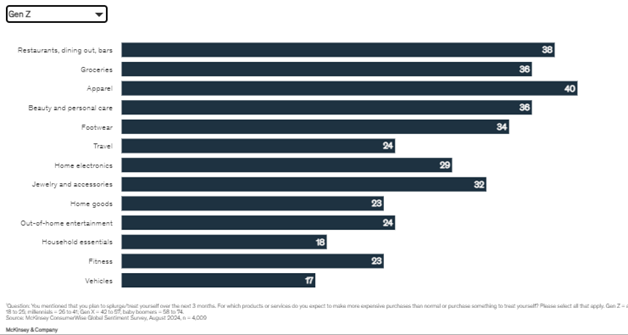
Let’s dive further into the generations and their similarities and differences in 2024 spending habits:
1. Digital Spending
Gen Z: 80% of Gen Z’s shopping occurs online (Statista)
Millennials: 75% of Millennials prefer online shopping (eMarketer)
Gen X: 65% of Gen Xers shop online regularly (Statista)
Baby Boomers: 55% of Baby Boomers shop online, though this segment is growing rapidly (eMarketer)
2. Social Media Influence
Gen Z: 80% of Gen Z discover new products through social media (Hootsuite)
Millennials: 65% of Millennials use social media to research products (Statista)
Gen X: 45% of Gen Xers use social media for product research (Statista)
Baby Boomers: 25% of Baby Boomers use social media for product research (Statista)
3. Value for Money
Gen Z: 75% of Gen Z prioritize value for money and are more likely to seek out discounts and promotions (Deloitte)
Millennials: 65% of Millennials are price-conscious and actively compare prices online (Statista)
Gen X: 55% of Gen Xers are budget-conscious and look for deals and discounts (Nielsen)
Baby Boomers: 40% of Baby Boomers prioritize value but may be more willing to pay a premium for quality and brand loyalty (Statista)
4. Sustainability
Gen Z: 80% of Gen Z are more likely to buy from brands that prioritize sustainability (Deloitte)
Millennials: 60% of Millennials prioritize sustainability in their purchasing decisions (Nielsen)
Gen X: 45% of Gen Xers consider sustainability factors when making purchases (Nielsen)
Baby Boomers: 30% of Baby Boomers consider sustainability, but it’s less of a primary driver compared to younger generations (Nielsen)
5. Brand Loyalty
Gen Z: 50% of Gen Z are more likely to be loyal to brands that align with their values (Deloitte)
Millennials: 60% of Millennials are brand loyal, but open to trying new brands (Nielsen)
Gen X: 70% of Gen Xers tend to be brand loyal and prefer established brands (Nielsen)
Baby Boomers: 80% of Baby Boomers are highly brand loyal and tend to stick with brands they trust (Nielsen)
It is important to keep in mind that each generation is comprised of unique personalities, lifestyles and purchasing habits. These tactics can serve as a good guideline when developing messaging and also when used used in conjunction with segmenting, analytics and other data-driven marketing methods.




